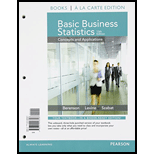
a.
Decide the optimal action based on the maximax criterion.
b.
Decide the optimal action based on the Maximin criterion.
c.
Find the expected monetary value for each action.
d.
Find the expected opportunity loss for each action.
e.
Explain the meaning of the
f.
Explain the reason for selecting either of the action from the results of parts (c) and (d).
g.
Find the coefficient of variation for each action.
h.
Find the return-to-risk ratio
i.
Explain the reason for selecting either of the action from the results of parts (g) and (h).
j.
Compare the results of parts (f) and (i) and explain any difference.
k.
Find the expected monetary value for each investment alternative when the probabilities of the different economic conditions are as given below.
0.1, 0.6 and 0.3
0.1, 0.3 and 0.6
0.4, 0.4 and 0.2
0.6, 0.3 and 0.1
Find the expected opportunity loss for each investment alternative when the probabilities of economic conditions are as given below.
0.1, 0.6 and 0.3
0.1, 0.3 and 0.6
0.4, 0.4 and 0.2
0.6, 0.3 and 0.1
Explain the meaning of the expected value of perfect information for this problem when the probabilities of each investment are as given below.
0.1,0.6 and 0.3
0.1,0.3 and 0.6
0.4,0.4 and 0.2
0.6,0.3 and 0.1
Explain the reason for selecting the investment from the results of parts (c) and (d) when the probabilities of each investment are as given below.
0.1, 0.6, and 0.3
0.1, 0.3, and 0.6
0.4, 0.4, and 0.2
0.6, 0.3, and 0.1
Find the coefficient of variation for each investment when the probabilities of different economic conditions are as given below.
0.1, 0.6, and 0.3
0.1, 0.3, and 0.6
0.4, 0.4, and 0.2
0.6, 0.3, and 0.1
Find the return-to-risk ratio
0.1, 0.6, and 0.3
0.1, 0.3, and 0.6
0.4, 0.4, and 0.2
0.6, 0.3, and 0.1
Explain the reason for selecting the investment from the results of coefficient of variation and RTRR when the probabilities of different economic conditions are:
0.1, 0.6, and 0.3
0.1, 0.3, and 0.6
0.4, 0.4, and 0.2
0.6, 0.3, and 0.1
Compare the results of parts (f) and (i) and explain the difference when the probabilities of different economic conditions are:
0.1, 0.6, and 0.3
0.1, 0.3, and 0.6
0.4, 0.4, and 0.2
0.6, 0.3, and 0.1
Want to see the full answer?
Check out a sample textbook solution
Chapter 20 Solutions
Basic Business Statistics Student Value Edition Plus NEW MyLab Statistics with Pearson eText -- Access Card Package (13th Edition)
- Should you be confident in applying your regression equation to estimate the heart rate of a python at 35°C? Why or why not?arrow_forwardGiven your fitted regression line, what would be the residual for snake #5 (10 C)?arrow_forwardCalculate the 95% confidence interval around your estimate of r using Fisher’s z-transformation. In your final answer, make sure to back-transform to the original units.arrow_forward
- BUSINESS DISCUSSarrow_forwardA researcher wishes to estimate, with 90% confidence, the population proportion of adults who support labeling legislation for genetically modified organisms (GMOs). Her estimate must be accurate within 4% of the true proportion. (a) No preliminary estimate is available. Find the minimum sample size needed. (b) Find the minimum sample size needed, using a prior study that found that 65% of the respondents said they support labeling legislation for GMOs. (c) Compare the results from parts (a) and (b). ... (a) What is the minimum sample size needed assuming that no prior information is available? n = (Round up to the nearest whole number as needed.)arrow_forwardThe table available below shows the costs per mile (in cents) for a sample of automobiles. At a = 0.05, can you conclude that at least one mean cost per mile is different from the others? Click on the icon to view the data table. Let Hss, HMS, HLS, Hsuv and Hмy represent the mean costs per mile for small sedans, medium sedans, large sedans, SUV 4WDs, and minivans respectively. What are the hypotheses for this test? OA. Ho: Not all the means are equal. Ha Hss HMS HLS HSUV HMV B. Ho Hss HMS HLS HSUV = μMV Ha: Hss *HMS *HLS*HSUV * HMV C. Ho Hss HMS HLS HSUV =μMV = = H: Not all the means are equal. D. Ho Hss HMS HLS HSUV HMV Ha Hss HMS HLS =HSUV = HMVarrow_forward
 College Algebra (MindTap Course List)AlgebraISBN:9781305652231Author:R. David Gustafson, Jeff HughesPublisher:Cengage Learning
College Algebra (MindTap Course List)AlgebraISBN:9781305652231Author:R. David Gustafson, Jeff HughesPublisher:Cengage Learning
